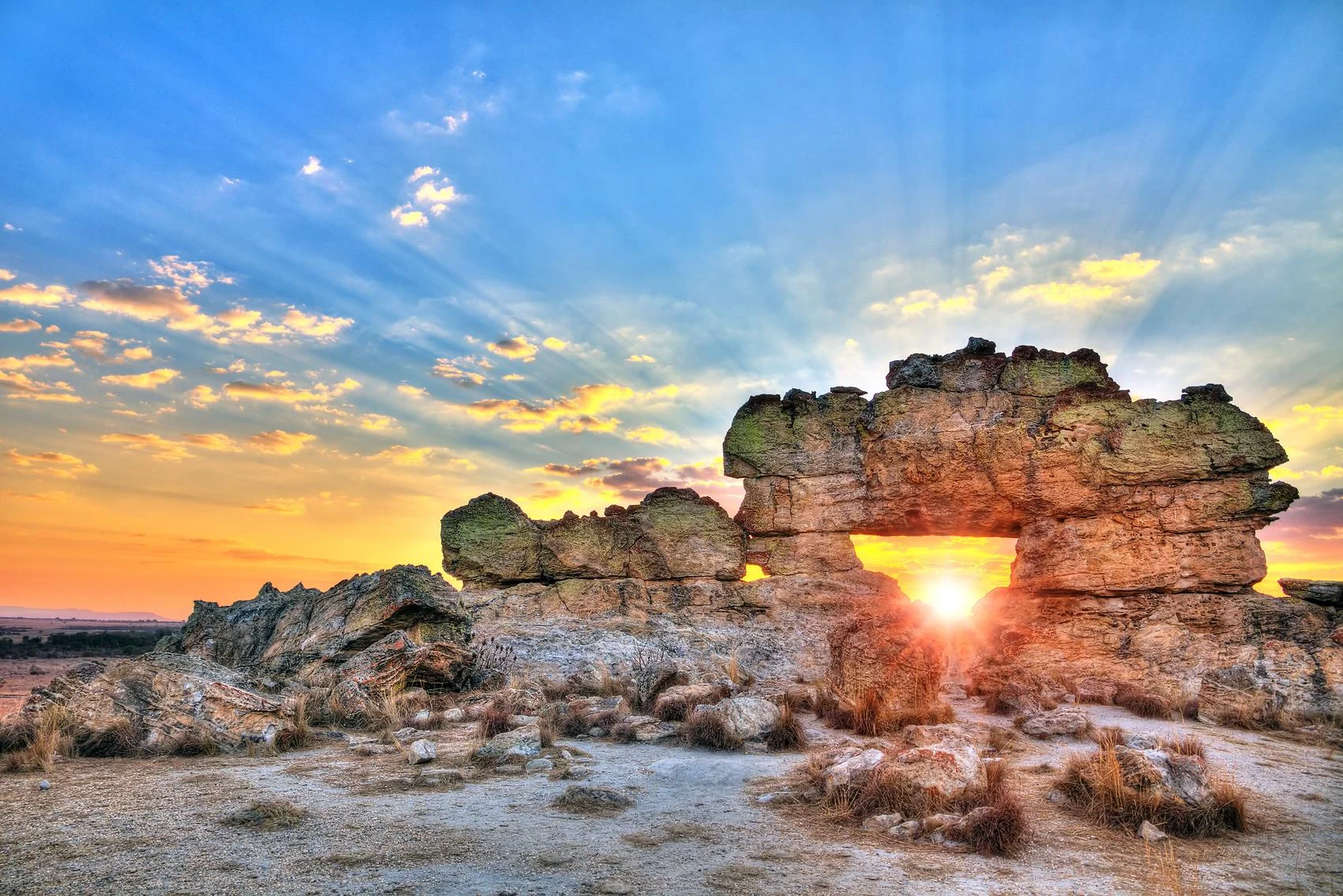Isalo National Park in Southwest Madagascar offers gorges, canyons, streams, dense forests, and expansive grasslands. It’s a must-see for nature lovers and tourists alike.
About the Park
Located 700 kilometers southwest of Antananarivo, Isalo National Park spans 815 square kilometers of protected land. Comprised of wind-eroded sandstone ridges (known as “runiformes”), the park boasts canons, rock formations, gorges, and stalagmites.
The rich mineral deposits and dense forests offer much to be explored, and are reminiscent of America’s Utah and Nevada. With both grasslands and forest, it’s an outdoorsman’s dream, offering both hours-long and days-long hikes.
As with most parks in Madagascar, wildlife is abundant; expect to see sifakas, ring-tailed lemurs, Malagasy rainbow frogs, Coquerel’s giant mouse lemur and 14 species of nocturnal lemurs.
The park also boasts 35 species of reptile, endemic frogs, and over 500 species of plant, such as the elephant’s foot, aloe, and palms. With a dense forest, 81 bird species have been recorded, 27 of which are endemic to Madagascar.
As with most other parks in Madagascar, a guide is required to visit the park. Be warned that this is a popular destination, so there will be many guides to choose from. I recommend picking one that speaks your native language and is not too pushy upfront.
- Entry fee: 65,000 AR (single day), 110,000 Ar (two days)
- Guide fee: 80,000 to 150,000 (depending on route)
The climate is tropical and warm all year round, so there’s a never a bad time to visit. Temperatures average 85 F/30 C, with little rainfall. However, the park gets busy in July, August, and December, so the trails might be a little more congested in peak season.
Must-See Trails
Isalo National Park is mainly a hiker’s destination, so we’ve outlined our favorite trails.
The Piscine Naturelle
At the end of this 7 mile (11 km) trail you’ll find a natural stone alcove with a waterfall and pandanus trees that drop from overhead. Think of this as the oasis in the desert that comes straight out of a movie. The water is a deep shade of green and acts as a natural swimming pool.
Most visitors combine a visit to the Piscine Naturelle with a hike into the Canon des Singes, as a dip in the cool water is the best way to cool down. Visitors report seeing ring-tailed lemurs, red fronted brown lemurs, endemic birds, frogs, and an abundance of flora while swimming.
One reviewer advises, “We did the walk to the naturele piscine (about 10kms) anti-clockwise, starting along the ridge, arriving at the pool about midday. The walk doesn’t provide much shade, so go prepared with all the necessaries.”
Namaza Circuit
Like the Piscine Naturelle, this trail takes you through the forest and to a natural swimming pool. On your hike, you’ll see vegetation, a waterfall, and a natural swimming pool. Due to its rough terrain, we suggest being prepared with hiking shoes and plenty of water (remember, it gets hot).
If you’re really up for a challenge, you can extend your hike to the Portuguese cave at the northern end of the park. This will take you through the Sahanafa forest, where you’ll see abundant wildlife, flora, and a natural hot springs. In total, this will take about 4 days.
The Canyon des Singes
For more seasoned hikers, the Cave of Monkeys (Canyon de Singes) is a great way to explore the various types of terrain. Trekking though both the forest and canyon, you’ll see ring-tailed lemurs and sifakas. Most visitors combine this with the Piscine Naturelle, again to cool down at the end of a long hike.
Getting Around
The roads near Isalo are well maintained, so your trip to the park should be mostly comfortable. You’ll get to the park by way of Ranohira, and the closest cities are Tana (15 hours away) and Tulear (4 hours away). It’s easiest to catch a taxi brousse, as they run daily.
If you’re coming from the Madagascan capital of Antananarivo, combine your trip with another national park on the way. We highly recommend seeing Ranomafana National Park, rich in fauna endemic to Madagascar’s tropical forests.
Where to Stay
There are multiple hotels just south of the park, offering unique bungalows, restaurants, and even a spa. Or, you can stay in one of the park’s two campgrounds. Both offer shared toilets, showers, and basic features commonly found at other campsites.
For any other information, the park office is a wonderful resource; it offers general park information, English-speaking guides, and a cool museum with all sorts of history on the region, geology, and specifics about the plants and animals you’ll see on your hike.



